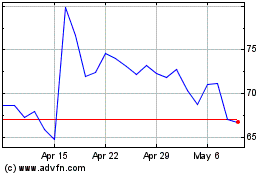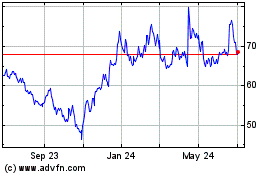Intra-Cellular Therapies, Inc. (Nasdaq: ITCI), a
biopharmaceutical company focused on the development and
commercialization of therapeutics for central nervous system (CNS)
disorders, today announced the initiation of clinical programs for
the Company’s lumateperone long-acting injectable formulation
(ITI-LLAI) and for ITI-333, a novel molecule for the treatment of
opioid use disorder.
“I am pleased to announce that two important proprietary
programs have advanced into human clinical testing, further
demonstrating our commitment to patients through the development of
novel treatments for schizophrenia, mood disorders and other
neuropsychiatric and neurologic disorders,” said Dr. Sharon
Mates, Chairman and CEO of Intra-Cellular Therapies.
LLAI, Study ITI-007-025: A Phase 1 single ascending dose study
of LLAI, a formulation designed to be administered subcutaneously
and to maintain therapeutic levels of lumateperone for at least 1
month. This study will evaluate the pharmacokinetics, safety and
tolerability of lumateperone LAI in patients with stable symptoms
of schizophrenia. Results from this study will inform the dosing
strategy for future studies.
Maintaining patients symptomatically stable and functional are
the primary objectives of the treatment of schizophrenia.
Long-acting injectable antipsychotics provide patients with blood
concentrations of active drug that remain within a therapeutic
range for an extended period. These formulations represent a
treatment option for patients who prefer not to take medication
daily or have history of poor adherence to oral treatments as they
have the potential to improve adherence and prevent relapse. Oral
lumateperone has demonstrated efficacy in treating schizophrenia
symptoms with a favorable safety and tolerability profile. A
long-acting formulation of lumateperone if successfully developed
and approved will provide an additional option for patients.
ITI-333, Study ITI-333-001: A Phase 1 single ascending dose
study evaluating the safety, tolerability and pharmacokinetics of
ITI-333 in healthy volunteers. ITI333 is a novel compound that
uniquely combines activity as an antagonist at serotonin 5-HT2A
receptors and a partial agonist at μ-opioid receptors. These
combined actions support the potential utility of ITI-333 in the
treatment of opioid use disorder and associated comorbidities
(e.g., depression, anxiety, sleep disorders) without opioid-like
safety and tolerability concerns.
Opioid use disorder is a chronic disorder with over 10 million
people in the United States having misused opioids and nearly
fifty-thousand persons died from opioid drug overdoses in 2018.
About Lumateperone Long Acting Injectable (LLAI)
formulation
The Company is developing a long-acting injectable formulation
of lumateperone (LLAI) that is designed for once monthly
administration by subcutaneous injection for the treatment of
schizophrenia. Nonclinical studies in rodents and monkeys have
shown the LLAI formulation is safe and well tolerated in single and
once monthly multiple dose studies and sustains plasma lumateperone
levels for 28 day or longer after each injection.
Pharmacodynamic studies have shown lumateperone acts as a potent
serotonin 5-HT2A receptor antagonist with high binding
affinity, as a postsynaptic D2 receptor antagonist with moderate
binding affinity, as an inhibitor of the serotonin reuptake
transporter (SERT) with moderate binding affinity. Lumateperone
also has moderate binding affinity to the D1 receptor (which may
contribute to the indirect activation of NMDA and AMPA
neurotransmission). These drug targets are believed to play
an important role in in schizophrenia, bipolar disorder, depressive
disorders and other neuropsychiatric disorders. In vitro
studies have shown lumateperone has a ~60-fold greater affinity for
5-HT2A receptors vs D2 receptors.
Lumateperone is being investigated for the treatment of bipolar
depression, major depressive disorders and other neuropsychiatric
and neurological disorders. Lumateperone is not FDA approved for
these disorders. CAPLYTA 42 mg (lumateperone) is approved by
the U.S. Food and Drug Administration for the treatment
schizophrenia of adults.
About ITI-333
ITI333 is a novel compound that uniquely combines activity as an
antagonist at serotonin 5-HT2A receptors and a partial agonist at
μ-opioid receptors. These combined actions support the potential
utility of ITI-333 in the treatment of opioid use disorder and
associated comorbidities (e.g., depression, anxiety, sleep
disorders) without opioid-like safety and tolerability concerns. In
addition, ITI-333 exhibits analgesic efficacy in acute and chronic
preclinical models of pain supporting its potential utility in the
management of pain.
ITI333’s pharmacology is predominantly driven by high affinity
binding to serotonin 5-HT2A (Ki = 8.3 nM) and μ-opioid (Ki = 11 nM)
receptors. ITI333 shows modest affinity for dopamine D1 receptors,
low affinity for κ-opioid receptors, and no binding to δ-opioid and
NOP receptors.
In vivo, ITI-333 elicits potent analgesia in rodents that is
blocked by the opioid antagonist, naloxone. Further, ITI-333
mitigates symptoms associated with opioid withdrawal and blocks
reinstatement of opioid mediated behaviors; behaviors thought to be
associated with a return to opioid use after a period of
abstinence.
ITI-333 possesses low potential for abuse liability. Unlike
opioid agonists, ITI-333 is not self-administered, does not develop
physical tolerance/dependences and does not impair gastrointestinal
and pulmonary function. This pharmacologic profile is unique and
supports the study of ITI-333 in humans as a potential treatment
for opioid use disorder and pain.
Intra-Cellular Therapies has received a grant from the National
Institute on Drug Abuse as part of the NIH Helping to End Addiction
Long-term initiative, or HEAL, to support the early clinical
development of ITI-333 for the treatment of opioid use
disorder.
CAPLYTA™ (lumateperone) is indicated for the treatment of
schizophrenia in adults. CAPLYTA is available in 42 mg
capsules.
Important Safety
InformationBoxed Warning: Elderly patients with
dementia-related psychosis treated with antipsychotic drugs are at
an increased risk of death. CAPLYTA is not approved for the
treatment of patients with dementia-related
psychosis.Contraindications: CAPLYTA
is contraindicated in patients with known hypersensitivity to
lumateperone or any components of CAPLYTA. Reactions have included
pruritus, rash (e.g. allergic dermatitis, papular rash, and
generalized rash), and urticaria.Warnings &
Precautions: Antipsychotic drugs have been reported
to cause:
- Cerebrovascular Adverse Reactions in Elderly Patients
with Dementia-Related Psychosis, including stroke and
transient ischemic attack. See Boxed Warning above.
- Neuroleptic Malignant Syndrome (NMS), which is
a potentially fatal reaction. Signs and symptoms include: high
fever, stiff muscles, confusion, changes in breathing, heart rate,
and blood pressure, elevated creatinine phosphokinase,
myoglobinuria (and/or rhabdomyolysis), and acute renal failure.
Patients who experience signs and symptoms of NMS should
immediately contact their doctor or go to the emergency room.
- Tardive Dyskinesia, a syndrome of uncontrolled
body movements in the face, tongue, or other body parts, which may
increase with duration of treatment and total cumulative dose. TD
may not go away, even if CAPLYTA is discontinued. It can also occur
after CAPLYTA is discontinued.
- Metabolic Changes, including hyperglycemia,
diabetes mellitus, dyslipidemia, and weight gain. Hyperglycemia, in
some cases extreme and associated with ketoacidosis, hyperosmolar
coma or death, has been reported in patients treated with
antipsychotics. Measure weight and assess fasting plasma glucose
and lipids when initiating CAPLYTA and monitor periodically during
long-term treatment.
- Leukopenia, Neutropenia, and Agranulocytosis (including
fatal cases). Complete blood counts should be performed in
patients with pre-existing low white blood cell count (WBC) or
history of leukopenia or neutropenia. CAPLYTA should be
discontinued if clinically significant decline in WBC occurs in
absence of other causative factors.
- Decreased Blood Pressure & Dizziness.
Patients may feel lightheaded, dizzy or faint when they rise too
quickly from a sitting or lying position (orthostatic hypotension).
Heart rate and blood pressure should be monitored and patients
should be warned with known cardiovascular or cerebrovascular
disease. Orthostatic vital signs should be monitored in patients
who are vulnerable to hypotension.
- Falls. CAPLYTA may cause sleepiness or
dizziness and can slow thinking and motor skills, which may lead to
falls and, consequently, fractures and other injuries. Patients
should be assessed for risk when using CAPLYTA.
- Seizures. CAPLYTA should be used cautiously in
patients with a history of seizures or with conditions that lower
seizure threshold.
- Sleepiness and Trouble Concentrating. Patients
should use caution when operating machinery or motor vehicles until
they know how CAPLYTA affects them.
- Body Temperature Dysregulation. CAPLYTA should
be used with caution in patients who may experience conditions that
may increase core body temperature such as strenuous exercise,
extreme heat, dehydration, or concomitant anticholinergics.
- Dysphagia. CAPLYTA should be used with caution
in patients at risk for aspiration.Drug
Interactions: CAPLYTA should not be used with CYP3A4
inducers, moderate or strong CYP3A4 inhibitors and UGT
inhibitors.Special Populations: Newborn
infants exposed to antipsychotic drugs during the third trimester
of pregnancy are at risk for extrapyramidal and/or withdrawal
symptoms following delivery. Breastfeeding is not recommended. Use
of CAPLYTA should be avoided in patients with moderate or severe
liver problems.Adverse
Reactions: The most common adverse
reactions in clinical trials with CAPLYTA vs. placebo were
somnolence/sedation (24% vs. 10%) and dry mouth (6% vs. 2%).Please
click here to see full Prescribing Information including Boxed
Warning.
About Intra-Cellular
TherapiesIntra-Cellular Therapies is a
biopharmaceutical company founded on Nobel prize-winning
research that allows us to understand how therapies affect the
inner-workings of cells in the body. The company leverages this
intracellular approach to develop innovative treatments for people
living with complex psychiatric and neurologic diseases.
Forward-Looking StatementsThis news release
contains "forward-looking statements" within the meaning of the
Private Securities Litigation Reform Act of 1995 that involve risks
and uncertainties that could cause actual results to be materially
different from historical results or from any future results
expressed or implied by such forward-looking statements. Such
forward-looking statements include statements regarding, among
other things, our beliefs about the potential utility of our
product candidates; our belief that a long-acting injectable
formulation of lumateperone could represent an important treatment
option for patients; our expectation that we will continue to
invest in our drug development pipeline; and development efforts
and plans under the caption “About Intra-Cellular Therapies.” All
such forward-looking statements are based on management's present
expectations and are subject to certain factors, risks and
uncertainties that may cause actual results, outcome of events,
timing and performance to differ materially from those expressed or
implied by such statements. These risks and uncertainties include,
but are not limited to, the following: the COVID-19 pandemic may
negatively impact the conduct of, and the timing of enrollment,
completion and reporting with respect to, our clinical trials; any
other impacts on our business as a result of or related to the
COVID-19 pandemic; risks associated with our current and planned
clinical trials; we may encounter unexpected safety or tolerability
issues in ongoing or future trials and other development
activities; our other product candidates may not be successful or
may take longer and be more costly than anticipated; product
candidates that appeared promising in earlier research and clinical
trials may not demonstrate safety and/or efficacy in larger-scale
or later clinical trials or in clinical trials for other
indications; our proposals with respect to the regulatory path for
our product candidates may not be acceptable to the FDA; our
reliance on collaborative partners and other third parties for
development of our product candidates; and the other risk factors
detailed in our public filings with the Securities and Exchange
Commission. All statements contained in this press release are made
only as of the date of this press release, and we do not intend to
update this information unless required by law.
Contact:
Intra-Cellular Therapies, Inc.Juan Sanchez, M.D. Vice
President, Corporate Communications and Investor
Relations646-440-9333
Burns McClellan, Inc.Lisa BurnsJohn
Grimaldijgrimaldi@burnsmc.com212-213-0006
Intra Cellular Therapies (NASDAQ:ITCI)
Historical Stock Chart
From Mar 2024 to Apr 2024

Intra Cellular Therapies (NASDAQ:ITCI)
Historical Stock Chart
From Apr 2023 to Apr 2024
